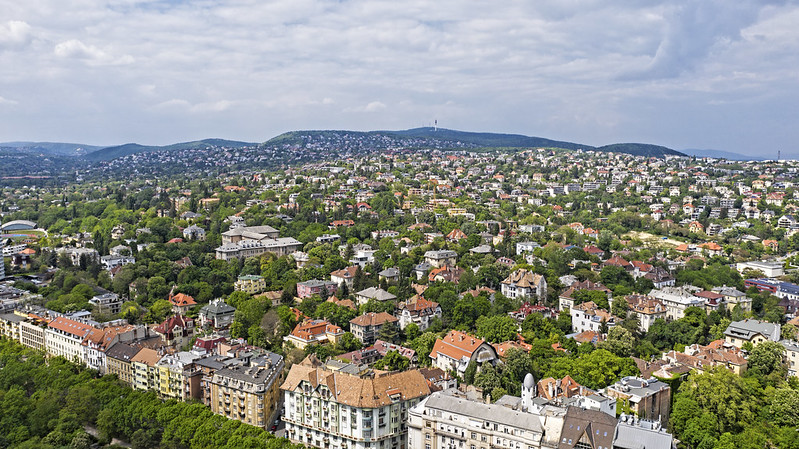The Ancient Roots of Buda
Buda, with its cobbled streets and Gothic houses, stands as a testament to Budapest’s rich history. This area was the central hub of settlement during the Middle Ages, preserving its ancient layout even today. While Pest remained relatively small until the late 18th century, it soon experienced a population boom, overshadowing Buda. However, the latter half of the 20th century saw a more balanced growth between the two. Today, Budapest spans an impressive 525 square km / 203 square miles, with Buda’s picturesque hilltops, the majestic Danube, and the iconic bridges contributing to the city’s unique visual identity.
Castle Hill: A Crown Jewel of Buda
At the heart of Buda lies Castle Hill, standing 168 meters / 551 feet above sea level. This hill is crowned by the beautifully restored Buda Castle, often referred to as the Royal Palace. The site originally housed a fortress in the 13th century, which was later replaced by a grand Baroque palace during Queen Maria Theresa’s reign in Hungary (1740–80). Over the years, the palace faced destruction and subsequent restorations, with the most recent being after World War II. Today, it is home to the National Széchényi Library, Budapest History Museum, and the Hungarian National Gallery.

Adjacent to the palace, the medieval Gothic Church of Our Blessed Lady, popularly known as Matthias Church, pierces the skyline. The Neo-Romanesque Fisherman’s Bastion stands proudly in front of the church, with a modern hotel nestled beside it.
Gellért Hill: A Panoramic Paradise
South of Castle Hill, the towering Gellért Hill offers breathtaking panoramic views of the entire city. The Citadel at its peak, built by the Austrian army in the mid-19th century, now serves as a hotel and restaurant. Every St. Stephen’s Day, this spot transforms into a stage for a dazzling fireworks display. The Liberation Statue near the Citadel stands as a reminder of the Soviet army’s victory over German forces in 1945.
![WP_20160507_10_15_39_Pro__highres[1]](https://live.staticflickr.com/7552/26461559193_afc4d19cdc_c.jpg)
Rose Hill (Rózsadomb): Where Elegance Meets History
Rózsa Hill, the third hill by the river, is Budapest’s most upscale district, housing the Hungarian elite. At its base, the Lukács Bath, a favorite among Budapest’s literati, offers a relaxing retreat.

The Urban Beauty Below
As you descend from the hills, the city unfolds before you. Margit Island, opposite Rózsa Hill, is a park spanning a mile, complete with hotels and swimming pools. On the Pest side, facing Castle Hill, the ornate Parliament Building stands tall. Inspired by London’s Houses of Parliament and completed in 1902, this Neo-Gothic marvel has remained largely unused since World War II. Further down the riverbank, the Hungarian Academy of Sciences and the Vigadó, both architectural masterpieces, await exploration.

Some interesting facts about Buda:
- Historical Significance: Buda was the historic capital of the Kingdom of Hungary. Since 1873, it has been the western part of the Hungarian capital, Budapest, situated on the west bank of the Danube.
- Landmarks: Buda is home to several iconic landmarks, including Buda Castle, the Citadella, and the residence of the president of Hungary, the Sándor Palace.
- Etymology: According to legends from the Middle Ages, the name “Buda” is believed to come from Bleda, the brother of the Hunnic ruler Attila. The city was once called Sicambria, named after Buda.
- Historical Roots: Buda was originally founded as a Celtic settlement. Later, the Romans established a fortified camp named Contra-Aquincum across the river from their military border camp at Aquincum.
- Medieval Importance: Buda became the nucleus around which the town was built and gained significant importance. By 1361, it became the capital of Hungary.
- Demographics: In the 15th century, while Pest had a Hungarian majority, Buda had a German majority. However, by the 19th century, Hungarians slowly became the majority in Buda.
- Ottoman Era: Buda became part of Ottoman-ruled central Hungary from 1541 to 1686. It was the capital of the province of Budin during this period. By the mid-17th century, Buda had become majority Muslim, largely due to an influx of Balkan Muslims.
- Reconquest: In 1686, Buda was reconquered by the Holy League’s army, which was twice as large as before and consisted of various European soldiers. This marked the end of the Ottoman rule in Buda.
- Post-Ottoman Era: After the reconquest of Buda, bourgeoisie from different parts of southern Germany moved into the city, which was almost deserted. Over time, as the rural population moved in, Hungarians became the majority.
- Notable Residents: Buda has been home to several notable figures, including Andrew III of Hungary, Jadwiga of Poland, John Corvinus, Louis II of Hungary, and Ignaz Philipp Semmelweis, an early pioneer of antiseptic procedures.